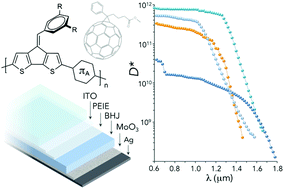Donor–acceptor polymers with tunable infrared photoresponse†
Abstract
Donor–acceptor (DA) conjugated polymers provide an important platform for the development of solution-processed optoelectronic devices. The complex interrelation between electronic properties and conformational disorder in these materials complicates the identification of design guidelines to control the bandgap at low energies, limiting the design of new optoelectronic and device functionalities. Here, we demonstrate that DA polymers comprised of exocyclic olefin substituted cyclopentadithiophene donors, in combination with conventional electron acceptors, display very narrow optical bandgaps (1.2 > Eoptg > 0.7 eV) and primary photoexcitations extending into the shortwave infrared. Theoretical calculations reveal fundamental structure–property relationships toward bandgap and energy level control in these spectral regions. Bulk heterojunction photodiodes fabricated using these new materials demonstrate a detectivity (D*) of > 1011 Jones within a spectral range of 0.6–1.43 μm and measurable D* to 1.8 μm, the longest reported to date for conjugated polymer based systems.



 Please wait while we load your content...
Please wait while we load your content...